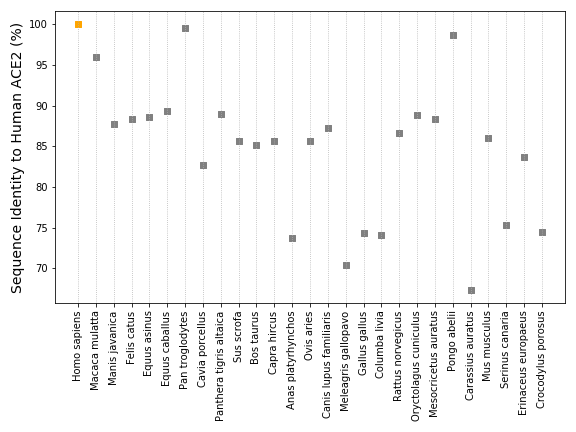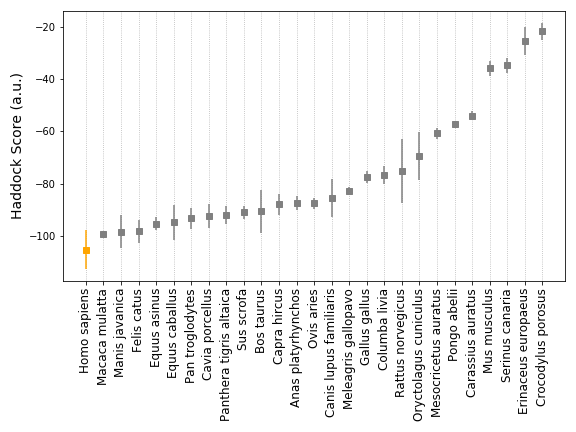(1/1) On one of our quarantine walks, my girlfriend told me about this tiger in a NY zoo that had tested positive for COVID-19. I was very skeptical and surprised that the virus could so easily jump across species, but decided to take a quick look, which turned into a fun story!
(2/2) My assumption was that to make such a jump, SARS-Cov-2& #39;s spike protein (S) had to bind the animal host ACE2 receptor somewhat decently. A quick trip to @rcsbPDB and @NCBI yielded more than enough sequences of ACE2 than I could ever want (including a tiger& #39;s!), as well as...
(3/3) a decent structure of human ACE2 bound to SARS-Cov-2 S (or part of it). Some modelling (MODELLER) and HADDOCKing ( @amjjbonvin) later, here are some interesting results. ACE2 is pretty conserved across species, with even crocodiles having 75% identity to the human variant.
(4/4) After HADDOCK refinement, turns out some species come pretty close to the human (native) complex. While these scores are not binding affinities (right @3Dstructure?), similar scores mean those interfaces form similarly strong contacts. So which species are these?
(5/5) In the top 5 we have the rhesus monkey, the pangolin (which has been proposed as an intermediate host), cats (which have also been reported as susceptible to COVID-19), and donkeys and horses. Not far off in terms of scores are guinea pigs, tigers (!!), pigs and cows and...
(6/6) other cattle/poultry. Mice (which have been reported not to be susceptible to infection) are 4th to last, with a score of nearly 30% of the human complex. I wanted to get bats in the mix, but the models keep exploding bc atoms end up overlapping... too much affinity?
(7/7) There are other interesting observations from modeling these species, mostly regarding glycosylation of ACE2. However, it *seems* like none of the sugars is close enough to the interface to play an important role in defining affinity/specificity. The cool thing is..
(8/8) that this ultra-simplistic modeling agrees (will not use the word correlate) qualitatively with observations from infection studies. Now what it be interesting to find out if some of these other high-scoring species can really act as carriers/reservoirs for the virus, or if
(9/9) this is just fiction :) Happy to share the models, scores, protocols, etc, with interested parties, just send me a DM or email. @amjjbonvin, this could be an interesting exercise for the Molecular Modeling students (modeling + docking), so we can retire good old p53 :)
(10/9) By the way. I am now convinced that it is possible that that poor NY tiger did get COVID-19. My question to virologists is: are viruses normally this promiscuous, or is SARS-Cov-2 special? I thought viruses needed quite some (more) adaptation to jump across hosts..

 Read on Twitter
Read on Twitter



